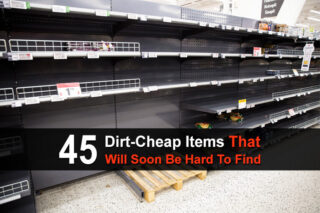Estimated reading time: 1 minute
We live in a time when the unexpected seems to happen all the time. And since all signs point to a future that is even more disruptive, preparedness is no longer a mere suggestion—it’s an absolute necessity.
While stockpiling dozens of survival items can seem overwhelming, it’s possible to amass a substantial cache of essential items without breaking the bank. You just have to get a little bit every week and be consistent. After a year or two, you’ll be amazed at how much stuff you have.
Beyond the basics of food and water, there are all sorts of affordable items that are crucial for survival and maintaining a sense of normalcy in difficult times. Even if you don’t use all these items, you could trade them for things you do need.
For this article, we’ve scoured the isles of dollar stores and sporting goods stores in search of practical, multipurpose items that could be lifesavers in a long-term disaster. Some of these may surprise you, but you’ll be happy to have them when the you-know-what hits the fan.
Want to save this post for later? Click Here to Pin It On Pinterest!
Here are some affordable items you should grab before they’re gone.
Bandanas – These can be used as makeshift masks, filters, bandages, or signaling flags. Their lightweight and compact nature make them an ideal multipurpose item.
Biodegradable Dish Soap – Essential for cleaning without negatively impacting the environment, and especially important if using natural water sources.
Clothespins – Useful for hanging laundry to dry, sealing opened food packages, or as improvised medical clamps in emergency situations.
Dental Emergency Kit – In case of severe tooth pain, a dental kit can help you get by until you can find a dentist.
Duct Tape – This stuff can be incredibly useful in a survival scenario.
Educational Books – In a long-term disaster, the Internet may be unreliable or completely unavailable. It’s a good idea to have a collection of survival books on hand.
Emergency Radio – For receiving news and weather updates without electricity.
Emergency Signaling Devices – Items like flares or signal mirrors can be lifesavers in situations where you need to attract the attention of rescuers.
Face Masks – Crucial for hygiene and protection in dusty or disease-prone environments.
First-Aid Manual – The information in a simple first-aid book could save someone’s life.
Fishing Gear – A simple fishing kit with hooks, line, and sinkers can provide a sustainable food source from local lakes and rivers.
Fixed-Blade Knife – A sturdy fixed-blade knife can be used for cutting, carving, food preparation, building shelter, or for self-defense.
Headlamps – These are incredibly useful during a blackout when you need to go to the bathroom or do anything that requires both hands.
Hand Sanitizer – For maintaining hygiene and preventing the spread of germs, especially when soap and water are not readily available.
Insect Repellent – Protects against diseases transmitted by insects, crucial in many environments.
Lighters – Every prepper should have a bunch of lighters on hand.
Local Maps – Detailed maps of your local area, including topographical maps, can be invaluable for navigation if GPS is unavailable.
Manual Can Opener – A vital tool for accessing preserved food stored in cans.
Multi-tool – A multi-tool can include functions like a knife, screwdriver, and can opener, condensing many tools into one for convenience and space-saving.
Multivitamins – Prevent nutritional deficiencies when food variety is limited.
Painkillers – Important in case of injuries or for people with chronic pain.
Paracord – Used for making shelters, repairing gear, or even fishing. Paracord can hold significant weight and is essential for any survival kit.
Personal Hygiene Items – Hygiene is especially important during disasters when diseases tend to spread more easily.
Portable Saw – A hand-powered saw is crucial for cutting wood for fires or constructing shelters.
Portable Solar Chargers – Keeps electronic devices powered in the absence of traditional electricity sources.
Portable Stove or Grill – So you can cook meals without power. Get one that can use more than one fuel source.
Portable Toilet – An essential where regular plumbing is compromised. Be sure to get biodegradable bags for waste.
Power Bank – High-capacity power banks can keep your mobile devices charged in the absence of electricity, crucial for communication and information.
Safety Goggles – Protect your eyes from dust, debris, and other hazards, especially during disaster cleanup or construction.
Soap Bars – Compact, long-lasting, and less wasteful than liquid soaps.
Solar Lanterns – Provide renewable lighting solutions, essential during power outages.
Spices and Seasonings – Just a few spices and seasonings can make boring, bland food into a delicious meal.
Tactical Flashlight – Beyond providing light, a tactical flashlight can be used for self-defense and signaling.
Thermal Blankets – Compact and lightweight, these blankets offer warmth in extreme conditions.
Water Filters – During a disaster, the tap water could be compromised or unavailable. Have a method for easily purifying it.
Whistle – A loud, durable whistle is vital for signaling for help in situations where you may be lost or in danger and need to attract attention.
Windproof and Waterproof Matches – These matches are invaluable for starting fires in adverse weather conditions, ensuring you can cook, boil water, or stay warm.
Work Gloves – Protects hands during manual labor and handling of rough or potentially hazardous materials.
Writing Supplies – Notebooks, pens, and pencils for recording information, keeping journals, or leaving messages, which can be crucial for organization and morale in long-term disasters.
Zip Ties – For makeshift repairs and securing items together, highly versatile and durable.
The importance of these items during a disaster can’t be overstated. They’re both cost-effective and multi-functional, offering a sense of preparedness and security in dangerous times. While they’re often overlooked in daily life, they’ll be extremely valuable during a long-term disaster.
But remember, preparedness isn’t just about accumulating supplies—it’s about knowing how to use your supplies when you need them. And not just the standard uses, but the unusual uses that most people wouldn’t think of.
With these items and the knowledge of how to use them, you’ll be much more resilient when ordinary life comes to a stop.
Like this post? Don't Forget to Pin It On Pinterest!
You May Also Like:













Bugging out is the last option. Bugging in, with shelter, supplies , food, and water and better security for a better defense!
Bug out now. Don’t wait until it’s to late. Cities are for the rich losers. Smart people are already out of the cities. I’ve been bugged out most of my life.